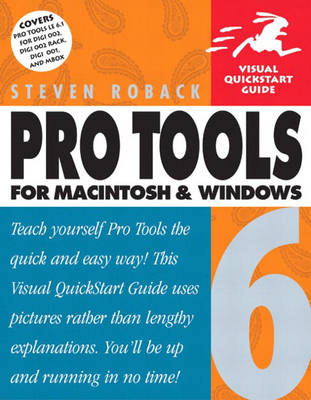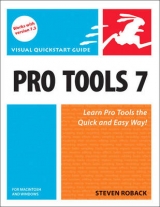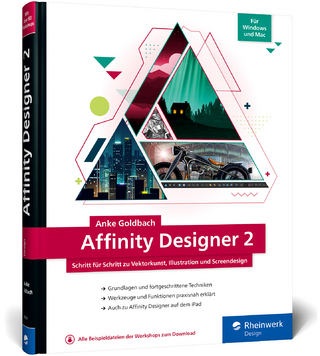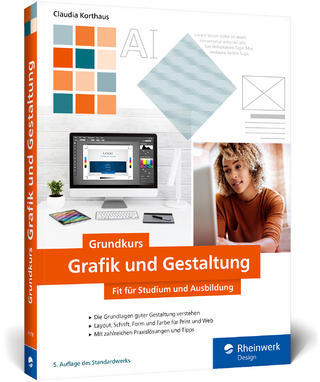
Pro Tools 6 for Macintosh and Windows
Peachpit Press Publications (Verlag)
978-0-321-21315-0 (ISBN)
- Titel erscheint in neuer Auflage
- Artikel merken
With a streamlined interface, the amazing DigiBase file management utility, enhanced MIDI functionality, and much more, the recently released Pro Tools 6 proves what you probably already knew: That Digidesign's Pro Tools software sets the standard for recording and editing digital audio. Here to make sense of it all--and to get you recording, editing, mixing, and processing effects quickly and efficiently--is the popular Visual QuickStart Guide on the topic, completely updated to cover all of Pro Tools 6.0's powerful new features. Through task-based, step-by-step instructions peppered with plenty of visual aids, this volume shows you how to make multitrack audio recordings with Pro Tools 6. Along the way you'll learn about the basics of automation, MIDI sequencing, and file management in Pro Tools as well as how to set up and use several mid-level Digidesign hardware systems. Beginning users will find all they need to begin creating audio masterworks, and pros will discover a valuable quick reference to their tool of choice.
Internationally acclaimed songwriter, musician, and producer Steven Roback has recorded more than a dozen albums since 1982 with his bands and as a solo artist. As co-founder of the influential Los Angeles band Rain Parade, Steven helped create an impressive catalog of neo-psychedelic songs that critics have called among the most important from any era. Later, his self-produced albums under the name Viva Saturn received accolades for hook-filled pop songwriting and hypnotically textured production. Today, Steven continues to record as a solo artist and soundtrack contributor. He also produces other artists and has received high praise for his work on several recent albums. Steven writes about audio recording and related topics for books and magazines. For more information, see www.rainparade.com.
Introduction.
I. GETTING STARTED WITH PRO TOOLS LE.
1. Setting Up Your Pro Tools LE System.
Understanding Pro Tools LE Hardware Systems. System Requirements. Connecting System Hardware. Installing Pro Tools LE Software.
2. Software Basics.
Understanding Sessions. Configuring Your Pro Tools 6 LE System.
3. The Mix and Edit Windows.
The Mix Window. The Edit Window.
II. RECORDING IN PRO TOOLS.
4. Starting a New Session.
Creating a New Session. Creating an I/O Setup. Creating Custom Session Templates. Sharing Sessions between Pro Tools LE and Pro Tools TDM.
5. Working with Tracks.
About Track Types. Creating New Tracks. Naming Tracks. Assigning Audio Track Inputs and Outputs. Viewing Tracks. Using Track Controls. Grouping Tracks. About Track Priority and Voice Assignments. Making Tracks Inactive.
6. Getting Ready to Record.
Setting Record Modes. Record-Enabling Tracks. Setting Audio Input Levels. Monitoring Audio. Minimizing Monitor Latency. Allocating Hard Drives. Allocating Hard Drive Space. Recording Audio with the Click Plug-in.
7. Recording and Playing Back Audio.
The Transport Window. Recording Audio Tracks. Punch-Recording Audio. Using QuickPunch. Loop-Recording Audio. Auditioning Takes. Recording to Playlists. Recording from a Digital Source. Playing Audio Tracks.
III. AUDIO FILE MANAGEMENT.
8. File Management Basics.
Locating Audio Files. Importing Audio. Setting Sample Rate Conversion Quality. Importing Tracks. Exporting Audio. Compacting and Deleting Audio Files. Transferring Audio from CD (Macintosh Only). Backing Up Your Files.
9. Managing Audio Files with DigiBase.
About DigiBase. About Browsers. Viewing Browsers. Using Browsers. Indexing. Searching Items. Waveforms and Auditioning Moving, Copying, Duplicating, and Deleting Items. Importing Audio Files Using Drag and Drop. Relinking Audio Files. Managing Background Processing with the Task Window.
IV. EDITING AUDIO.
10. Editing Basics.
Editing Audio in Pro Tools. Understanding Regions. Viewing Regions. Working with Playlists. Using the Audio Regions. Using Multiple Undo. Setting Edit Modes. Using Rulers. Using Memory Locations.
11. Working with Regions.
About Selections. Selecting Regions. Changing a Selection's Length. Nudging Selections. Extending a Selection. Using Selection Indicators. Tabbing to Transients. Making Timeline Selections. Creating New Regions. Placing Regions in Tracks. Sliding Regions. Aligning Regions. Identifying Sync Points. Trimming Regions. Nudging Regions. Using Edit Commands. Duplicating and Repeating Regions. Shifting Regions. Quantizing Regions. Locking Regions. Muting/Unmuting Regions. Managing Regions.
12. Advanced Editing.
Creating Fades and Crossfades. Creating Fades and Crossfades in Batches. Repairing Waveforms with the Pencil Tool. Stripping Silence from Regions. Inserting Silence.
V. MIXING AUDIO.
13. Mixing Basics.
Creating Stereo Mixes. Understanding Audio Signal Flow. Assigning Inputs and Outputs. About Inserts. Assigning Sends. Using Output Windows. Creating Submixes.
14. Adding Effects to a Mix.
What Is a DSP Plug-in? About Plug-ins as Inserts. Inserting Plug-ins on Tracks. Using Plug-in Windows. Bypassing Plug-ins. Adjusting Plug-in Parameters. What Is EQ? Using EQ. Using Dynamic Effects. Using Key Inputs for Side-Chain Processing. Creating Effects Loops. Using Delay Effects. What Is Reverb? Using Reverb. Using External Hardware Effects. Using AudioSuite Plug-ins. Improving RTAS Plug-in Performance.
15. Automating a Mix.
About Automation Modes. Enabling Automation. Writing Automation. Viewing Automation. Automating Sends. Automating Plug-ins. Editing Automation. Thinning Automation.
16. Mixdown and Mastering.
Bouncing to Disk. Setting Bounce Options. Mastering Basics.
VI. MIDI SEQUENCING.
17. Recording MIDI.
What Is MIDI? The Difference Between MIDI and Audio. MIDI in Pro Tools. OMS and MIDI Setup. MIDI Setup in Mac OS X. Selecting MIDI Inputs. Sending MIDI out of Pro Tools. Recording MIDI. Recording Multiple MIDI Tracks. Punch-Recording MIDI. Loop-Recording MIDI. Sysex Data and Pro Tools. Working with MIDI Files.
18. Editing MIDI.
MIDI Regions. Views for Editing MIDI. MIDI Playlists. Entering and Deleting MIDI Notes Manually. Editing MIDI Notes Manually. Editing MIDI Velocity. Editing MIDI Controller Data. Using Pro Tools MIDI Operations. The MIDI Event List. Virtual MIDI Inputs.
VII. GETTING THE MOST FROM PRO TOOLS.
19. Pro Tools for Digital Video.
Preparing to Edit Sound for Video. Choosing a Sample Rate and Bit Depth for Your New Project. Using Time Code or Feet.Frames Counter and Ruler (DV Toolkit Only). Working with a Video Deck. Session Setup for Accurate Synchronizing. Digitizing Your Guide Track from the Videotape. Checking Sync Accuracy. Using Digital Video to Sync Pro Tools to Picture. Getting Sync Audio from the Picture Editor. Editing Dialog (Production Sound). Working with Sound Effects. Editing Music for Video. Mixing for Video.
20. Optimizing Performance.
Managing CPU Power. Using Plug-ins Efficiently. Using Hard Drives Efficiently.
Appendix A: Connecting Your Studio.
Connecting Your Studio to the Digi 002, Digi 002 Rack, Digi 001, Mbox, or Audiomedia III. Connecting Audio Sources to Digi 002 and Digi 002 Rack. Connecting Audio Sources to Digi 001. Connecting Audio Sources to Mbox. Connecting Audio Sources to Audiomedia III. Connecting Audio Monitors. Connecting MIDI Devices. Connecting External Hardware Effects.
Appendix B: Setting Preferences.
The Preferences Dialog Box. Display Preferences. Operation Preferences. Editing Preferences. Automation Preferences. Processing Preferences. Compatibility Preferences. MIDI Preferences.
Glossary.
Index.
| Erscheint lt. Verlag | 28.10.2003 |
|---|---|
| Verlagsort | Berkeley |
| Sprache | englisch |
| Maße | 228 x 178 mm |
| Gewicht | 925 g |
| Themenwelt | Kunst / Musik / Theater ► Musik |
| Mathematik / Informatik ► Informatik ► Grafik / Design | |
| ISBN-10 | 0-321-21315-7 / 0321213157 |
| ISBN-13 | 978-0-321-21315-0 / 9780321213150 |
| Zustand | Neuware |
| Haben Sie eine Frage zum Produkt? |
aus dem Bereich



